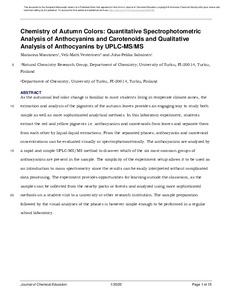Chemistry of Autumn Colors: Quantitative Spectrophotometric Analysis of Anthocyanins and Carotenoids and Qualitative Analysis of Anthocyanins by Ultra-performance Liquid Chromatography-Tandem Mass Spectrometry
Vesterinen Veli-Matti; Manninen Marianna; Salminen Juha-Pekka
https://urn.fi/URN:NBN:fi-fe2021042822890
Tiivistelmä
The autumnal leaf color change is a familiar phenomenon to most students living in temperate climate zones. The extraction and analysis of the pigments of the autumn leaves provide an engaging way to study the phenomenon utilizing both simple as well as more sophisticated analytical methods. In this laboratory experiment, students extract the red and yellow pigments, that is, anthocyanins and carotenoids from leaves and separate them from each other by liquid–liquid extractions. From the separated phases, anthocyanin and carotenoid concentrations can be evaluated visually or spectrophotometrically. The anthocyanins are analyzed by a rapid and simple ultra-performance liquid chromatography–tandem mass spectrometry method to discover which of the six most common groups of anthocyanins are present in the sample. The simplicity of the experiment setup allows it to be used as an introduction to mass spectrometry since the results can be easily interpreted without complicated data processing. The experiment provides opportunities for learning outside the classroom, as the samples can be collected from the nearby parks or forests and analyzed using more sophisticated methods on a student visit to a university or other research institution. The sample preparation followed by the visual analyses of the phases is however simple enough to be performed in a regular school laboratory.
Kokoelmat
- Rinnakkaistallenteet [19248]
